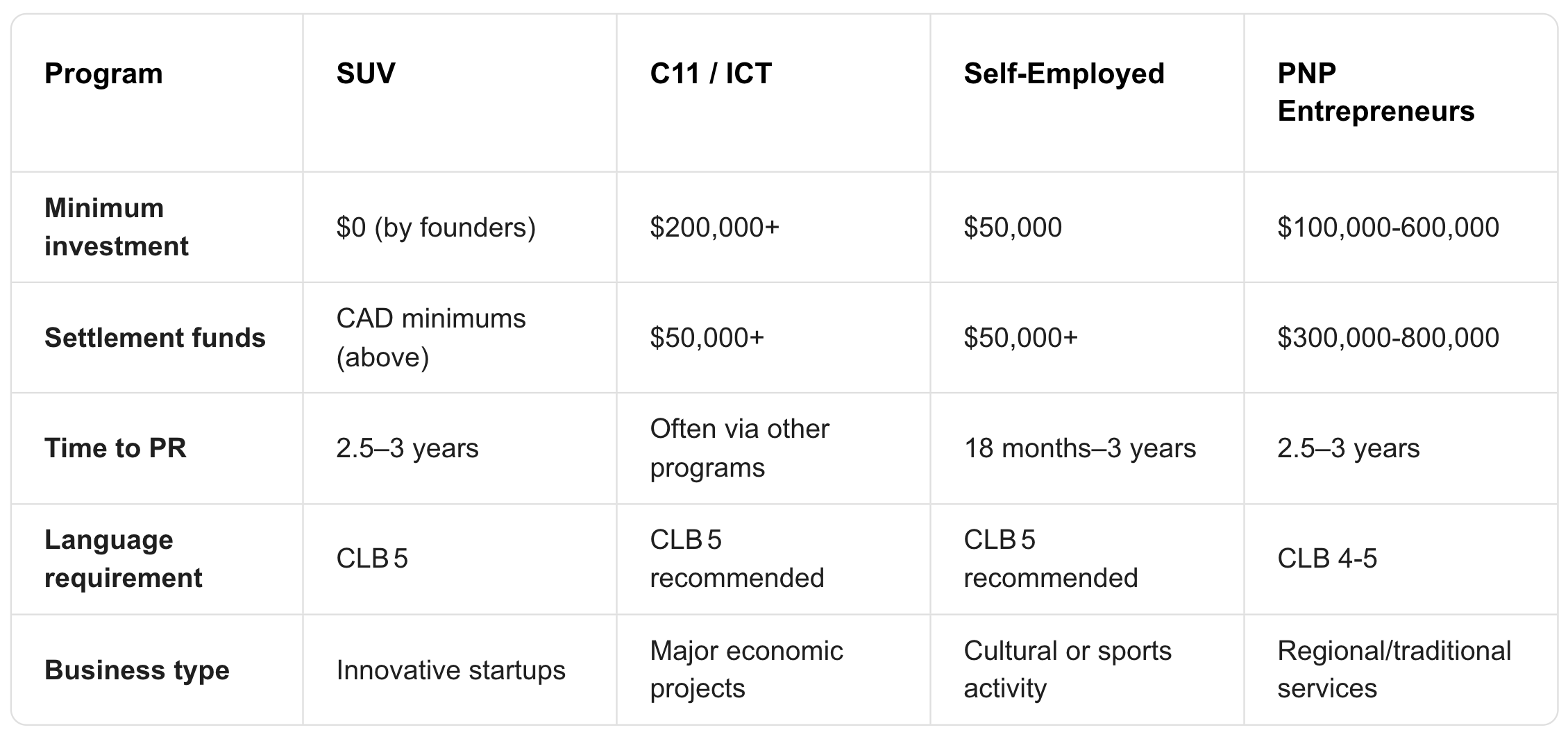
The Start‑Up Visa Program offers entrepreneurs a valuable opportunity to gain permanent residency in Canada by launching an innovative business. Unlike traditional investment programs, it does not require personal capital, prospective founders only need to secure an endorsement from a Canadian investor. Launched in 2013, the program gained popularity in 2018 and now attracts talent from around the world.
In 2025, the program’s annual intake has been reduced to 2,000 spots. While stricter limits have been placed on certain designated organizations, applicants now benefit from a three‑year open work permit, making the SUV more competitive yet more flexible for qualified entrepreneurs.
The Start‑Up Visa is a federal business‑immigration initiative designed to attract innovative entrepreneurs. It targets startups capable of creating jobs, competing internationally, and contributing to Canada’s economy. To participate, applicants must secure support from a designated organization — a venture capital fund, angel investor group, or business incubator.
Canada’s goal is not merely to attract capital, but rather talent and innovation. The country recognizes that successful startups build ecosystems, draw further investment, and contribute tax revenue more effectively than passive schemes. Consequently, the program focuses on the quality of the idea, founding team, and growth potential.
With endorsement in hand, approved applicants and their families can move to Canada within 3–6 months on an open work permit. Permanent residency typically follows within 2–3 years. Up to five founders can collaborate on a single project, each applying independently for immigration.
CBGA specializes in guiding entrepreneurs through the SUV process from crafting a market‑ready business strategy to obtaining permanent residency.
The SUV program has clearly defined eligibility requirements intended to attract high-potential entrepreneurs. Understanding these requirements is essential for preparing a strong application.
To qualify, applicants must:
The required minimum settlement funds are:
The business itself must demonstrate innovation as a core component. The product or service must stand apart from existing solutions and offer a novel approach or technology. Copying foreign business models without adaptation is rarely supported.
The business must also show scalability, with potential to grow beyond a local market. Designated organizations prefer startups with the capacity to become national or global leaders. Businesses focused only on local services, such as dry cleaners, do not qualify.
Creating jobs for Canadians is a critical element. The project must include a plan for hiring local talent, transferring knowledge, and contributing to the development of the startup ecosystem.
CBGA conducts in-depth analyses of business models, assessing whether projects meet SUV criteria and recommending improvements at the planning stage.It is also important to note that investment requirements differ by organization. Venture capital funds require at least CAD 200,000 in investment, angel groups require CAD 75,000, and business incubators may accept a project without any financial commitment.
In 2024, the Canadian government introduced major reforms to the SUV program, establishing new limits and priorities. These changes are aimed at improving the quality of applications but also raise the bar for potential participants.
A cap of 10 applications per designated organization per year has dramatically altered the competitive landscape. While successful organizations used to support dozens of projects, they must now be extremely selective. As a result, the quality of the application has become even more critical.
The overall annual quota was reduced from 5,000 to 2,000 in 2025, signaling a more conservative approach to immigration. The focus has shifted from volume to quality, favoring a smaller number of stronger applicants.Priority processing is now granted to applications involving Canadian funding sources. Startups supported by Canadian venture funds or innovation network members receive faster review times.
Three-year open work permits have also been introduced, allowing applicants to work for any employer in Canada while building their startup. Spouses are eligible for open work permits, and children can receive study permits.
CBGA has adapted its services to meet the new program realities, guiding clients in selecting organizations based on annual limits and helping them prepare competitive applications.
Given the new quota system, applications are now assessed on a "first submitted, first considered" basis. Submitting early in the year significantly improves the chances of acceptance.

As of December 2024, the average processing time for SUV applications was approximately 40 months — significantly longer than the 12 to 18 months seen in the program’s early years. This increase is due to growing popularity.
There were 29,128 individuals in the application queue across 9,125 cases. Of these, 14,508 were awaiting review, 10,458 were being assessed for eligibility, and only 4,030 were close to receiving final decisions.
Applications backed by Canadian funding and prioritized by IRCC may be processed in 24 to 30 months. However, the work permit stage typically takes only 2 to 6 months after receiving the Letter of Support.
According to IRCC data from January to November 2024, the approval rate was 77.2%, with 2,577 applications approved out of 3,334 processed. CBGA achieved a 95% success rate for its clients, thanks to its proven methodology and comprehensive support throughout the process.
Important! Applicants should also be aware that regular updates to IRCC on the progress of their business are now mandatory. Updates are recommended every six months following issuance of the work permit.
Canada offers several pathways to permanent residency through business immigration, each with its own benefits and limitations. A clear understanding of the available options allows entrepreneurs to choose the most suitable strategy based on their profile.
The Self-Employed Persons Program targets individuals with experience in cultural or athletic fields. It requires a demonstrated record of self-employment and a commitment to contributing to Canada’s cultural life. While the financial requirements are low—approximately CAD 50,000—the application processing times are long, and the program's applicability is narrowly defined.
Provincial Nominee Programs (PNPs) allow individual provinces to select entrepreneurs whose business plans align with local economic priorities. These programs typically require investments ranging from CAD 100,000 to 600,000, and proof of personal net worth between CAD 300,000 and 800,000. Applicants first receive a work permit, operate their business in the province, and may later be nominated for permanent residency.
The C11 work permit pathway is designed for entrepreneurs pursuing projects of significant economic benefit to Canada. While there is no direct route to permanent residency under this category, the permit provides an opportunity to develop a business that may later qualify for other immigration streams. The typical investment starts from CAD 200,000 and must demonstrate substantial public benefit.
The Intra-Company Transfer (ICT) option is for individuals being transferred to a Canadian branch of an international company in an executive, managerial, or specialized knowledge capacity. This pathway allows for expedited work authorization and bypasses labour market assessment requirements but is limited to existing multinational companies.

Start-Up Visa is most suitable for technology entrepreneurs and innovation-driven founders. It requires no personal investment, but the idea and team must be strong and scalable. PNPs are better suited for traditional or regionally focused businesses that follow proven models.Many applicants combine strategies, beginning with a temporary work permit, growing their venture, and transitioning to PNPs or SUV when conditions are favorable.
Achieving success under the SUV program requires a methodical approach and a full understanding of each step in the process. Each phase has its own unique requirements and potential challenges.
Step 1: Develop a Business Concept
This begins with market research and identifying the startup’s competitive advantages. Designated organizations seek projects that offer clear value propositions, feasible monetization strategies, and room for scalability. The business should address a real need in the Canadian or global market.
Market research should include analysis of market size, competition, regulatory environment, and customer segments. Special attention should be paid to the Canadian context, including cultural norms, consumer behavior, and technology adoption.
The business model must outline unit economics, monetization paths, scalability levers, and competitive differentiation. The financial model should project 3 to 5 years ahead, detailing revenue sources, cost structures, and key performance indicators.
Step 2: Select a Designated Organization
There are currently 84 designated organizations, categorized into three types: 32 venture capital funds, 27 angel groups, and 25 incubators. Venture capital funds focus on high-growth tech startups and require a minimum CAD 200,000 investment. Angel groups are more flexible, typically investing at least CAD 75,000, and often specialize in specific sectors. Business incubators do not require capital investment but offer mentorship and access to support ecosystems through structured 3 to 6-month programs.
Applicants should carefully research each organization’s portfolio, investment thesis, industry focus, team background, and success stories. It is essential to approach groups with a history of supporting similar businesses or with relevant domain expertise.
Administrative fees can vary significantly:
Step 3: Prepare and Submit the Pitch
A strong pitch deck should contain 10 to 12 slides covering the problem, solution, target market, competitive landscape, business model, team profile, financial projections, and use of funds. The initial 2–6 week review process includes interviews, reference checks, market validation, technical and legal due diligence.
A robust data room should also be prepared in advance, including financial statements, legal documents, IP records, customer lists, and technical materials.
CBGA guides clients through pitch creation, mock presentations, and the vetting process. Our established relationships with designated organizations help strengthen the application’s credibility.
Step 4: Submit the Immigration Application
This involves compiling extensive documentation: completed forms, Letter of Support, language test results, police clearances, medical exams, educational credentials, and proof of settlement funds. Supplementary materials such as the business plan, pitch deck, incorporation records, capitalization table, and financial documentation are also required. The quality of documentation significantly affects processing speed and outcomes.
In parallel, applicants should file for the open work permit. This three-year permit allows them to work for any employer in Canada while growing their business. Spouses and children are eligible for accompanying permits.

The total cost of participating in the Start-Up Visa Program typically ranges from USD 144,800 to 168,800, depending on the complexity of the project, chosen designated organization, and level of required services.
The program fee charged by designated organizations starts at USD 50,000. These fees vary depending on whether the organization is a venture capital fund, angel group, or business incubator, and whether they provide mentorship, access to networks, or require investment.
CBGA’s consulting services typically range from USD 15,800 to 39,800. These services include business concept development, market research, financial modeling, legal coordination, application guidance, and full support through the work permit and permanent residency stages.
Legal and professional services, including immigration consulting and corporate structuring, typically cost between USD 10,000 and 20,000. Government application fees add approximately USD 2,500 to 5,000 for a family of four.
The Start-Up Visa Program provides a unique combination of benefits and obstacles that entrepreneurs should consider before applying. A realistic view of both aspects will support informed decision-making.
Advantages
One of the program’s key advantages is its direct pathway to permanent residency. Unlike work permits or temporary visas, the SUV leads to PR, with citizenship eligibility after three years. This provides long-term stability and access to Canadian social benefits.
The absence of a personal investment requirement makes the SUV accessible to founders with strong ideas but limited capital. The focus on innovation and business potential rather than financial standing opens the door to younger or less capitalized entrepreneurs.
Additional benefits include equal access for all nationalities, no country quotas, and the ability for up to five co-founders to apply as part of one startup. The three-year open work permit provides income stability during startup development, and there are no restrictions on business activities or net worth requirements.
Challenges
However, there are also serious challenges. Competition for designated organization support has intensified, especially under the new 10-application limit. This scarcity raises the bar significantly, and many well-qualified projects may be rejected simply due to capacity constraints.Processing times have increased to over 40 months, making it difficult for founders to plan ahead. During this time, market dynamics and personal circumstances can change significantly. The risk of failure or project delay increases as the timeline extends.
There is also a risk that designated organizations may withdraw support if business progress falters. IRCC approval is not guaranteed, even with a Letter of Support. If a startup fails during the application stage, the founder’s immigration status may be at risk. Moreover, program criteria may change mid-process, affecting applicants' prospects.
CBGA offers long-term support that extends beyond the initial approval. Our team continues working with clients throughout the PR process, helping them remain compliant, solve business challenges, and meet government expectations.
Despite these hurdles, the SUV remains one of the most attractive global immigration options for innovative entrepreneurs. Success requires careful planning, professional execution, and continuous engagement.
Successful integration into Canada’s business environment requires early engagement with relevant government services and institutions. Knowing where to go and whom to contact can save time and reduce bureaucratic friction.
Major Canadian banks such as RBC, TD, and Scotiabank provide specialized services for newcomers, including business banking and financing. Credit unions like Coast Capital (BC), Meridian (Ontario), and Conexus (Saskatchewan) often have more flexible requirements and personalized service.
Important! Establish relationships with key service providers early in your relocation process. Many services require advance booking or involve waiting periods, especially in major urban centers.
The Start-Up Visa Program offers a promising path to permanent residency for entrepreneurs with bold ideas and global ambitions. Despite rising competition and processing delays, SUV remains one of the most founder-friendly immigration tracks in the world.Achieving success requires thoughtful preparation, commitment, and expert guidance. With its proven strategies and institutional connections, CBGA significantly improves applicants’ chances and makes the immigration process more predictable and manageable.
blog
.jpg)
Starting a business in another country can seem daunting, especially if you don’t have permanent resident (PR) status.
Read More.jpg)
Canada remains one of the most attractive destinations for business immigration thanks to its stable economy, transparent legal framework, and programs that offer a pathway to permanent residency (PR) through entrepreneurship.
Read MoreKeep Exploring

07.10.25
In less than two years, Canada’s Start-Up Visa has shifted from an open innovation policy to a controlled, performance-based filter.

22.07.25
Companies involved in zero-emission technology may qualify for additional tax relief in eligible sectors certified by the Canada Revenue Agency (CRA).

03.07.25
The Start‑Up Visa Program offers entrepreneurs a valuable opportunity to gain permanent residency in Canada by launching an innovative business.
Find the
Connect with the experts who can help you unlock your business’s full potential
Expertise
You Need
